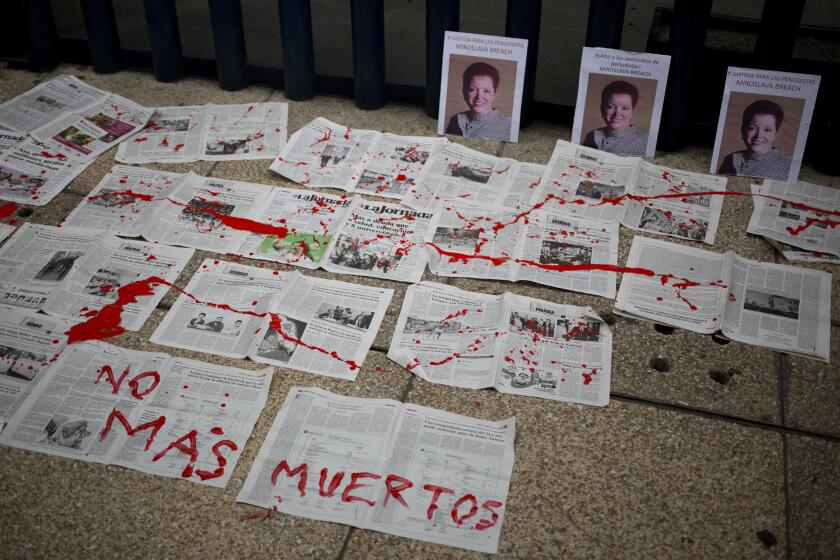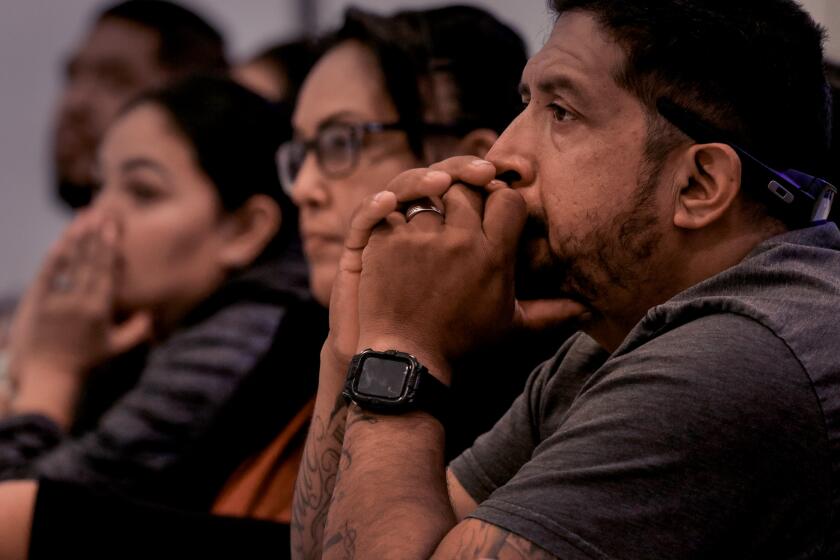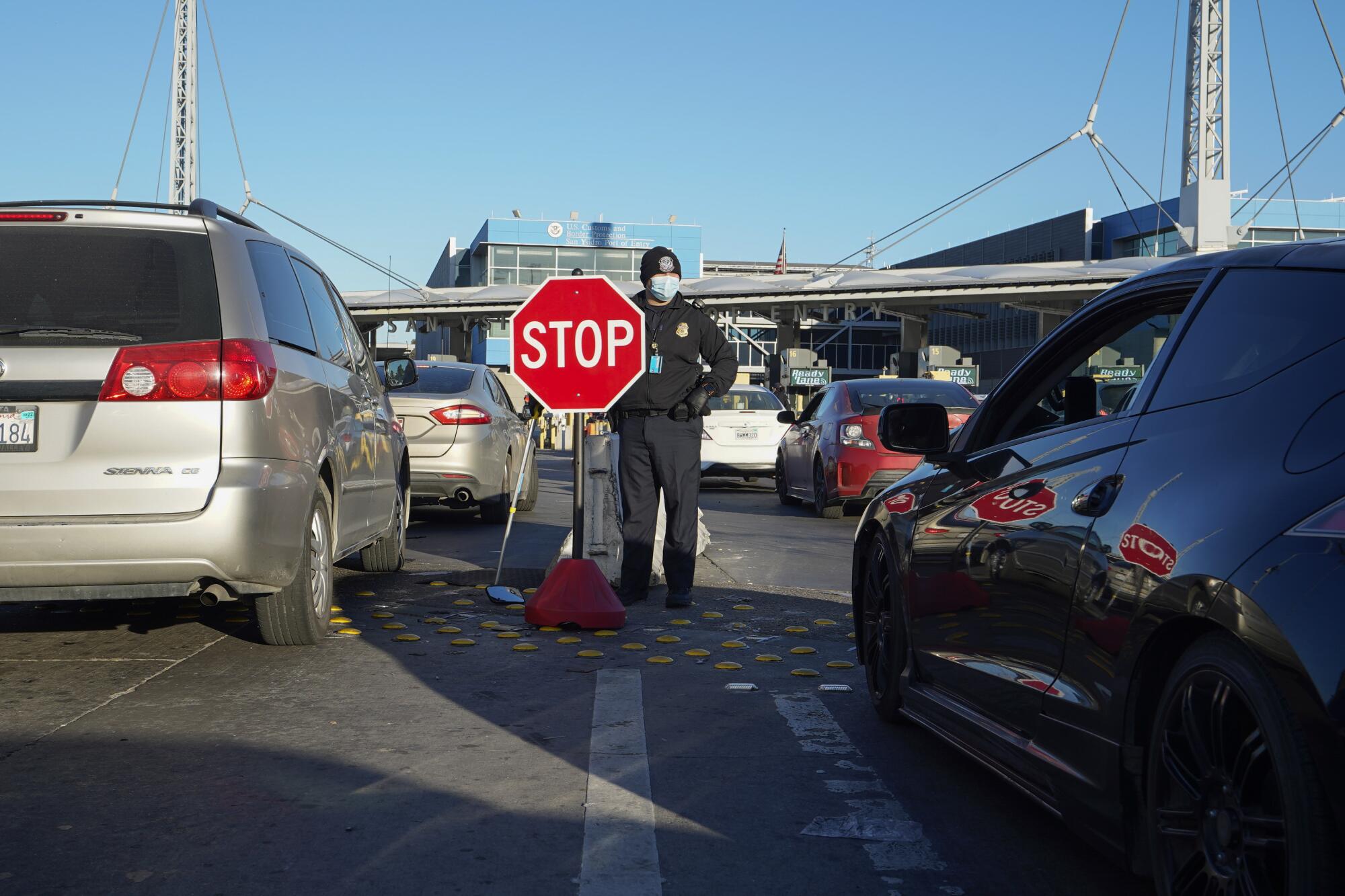
At the San Ysidro Port of Entry, border officials stand along the bustling car lanes, guarding a line of yellow bumps on the ground.
The officers’ presence, since at least summer of 2021, is the escalation of a years-old strategy to stop asylum seekers from reaching U.S. soil, where, under law, migrants have a right to request protection regardless of their manner of entry. The yellow bumps, known as the “limit line,” indicate the southernmost inches of the United States, the official border with Mexico.
For the record:
10:40 a.m. Feb. 8, 2022A previous headline on this post said that Border Patrol was increasing staffing. Customs and Border Protection is increasing officers at the border limit line to check identification before cars cross onto U.S soil and reach the booths where their documents are more officially inspected by CBP.
For years, border officials have stood at the limit line at pedestrian entrances to ports of entry to block asylum seekers traveling on foot. As a result of border policies under the pandemic, asylum seekers began using the car lanes to try to reach the United States, and Customs and Border Protection added officers at the limit line to check identification before cars cross onto U.S soil and reach the booths where their documents are more officially inspected by CBP.
Though ports of entry are once again allowing “nonessential travelers” to cross north, provided they are vaccinated and have permits to enter the United States, border officials have not restarted the processing of asylum seekers since the pandemic began.
That means that the only way for many to request protection is to cross without permission.
Doing so can be quite risky. Along the California border, it often means scaling a 30-foot border barrier, climbing through treacherous conditions over mountains, hiking through the dangers of the desert or clinging to a rickety panga boat through ocean currents.
Crossing through the car lanes — by running on foot or by buying or renting cars if they have the resources — presents a seemingly less perilous alternative. After some entered successfully, word spread among asylum seekers and on YouTube about the possibility of refuge after getting past the yellow, bumpy line.
Since CBP began stationing its officers at the limit line in the car lanes, tensions between asylum seekers desperate to reach U.S. soil and the officers told to block them have escalated. In December, an officer shot at cars driven by asylum seekers as they rolled into San Diego.
Meanwhile, advocates who support asylum seekers in the region have criticized CBP’s choice of resource allocation. They say that CBP could safely process some number of asylum seekers with the officers currently stationed at the limit line, alleviating the need for asylum seekers to drive into the United States in the first place.
“It’s this big show of force,” said Erika Pinheiro, litigation and policy director of Al Otro Lado, a legal services nonprofit that supports asylum seekers in Tijuana. “They always characterize it as an invasion rather than people using the only avenue that they have to seek protection.”
A federal judge ruled last year that CBP’s practice of turning back asylum seekers at the limit line is illegal, though that ruling does not cover the pandemic policy.
CBP did not respond to multiple requests for comment.
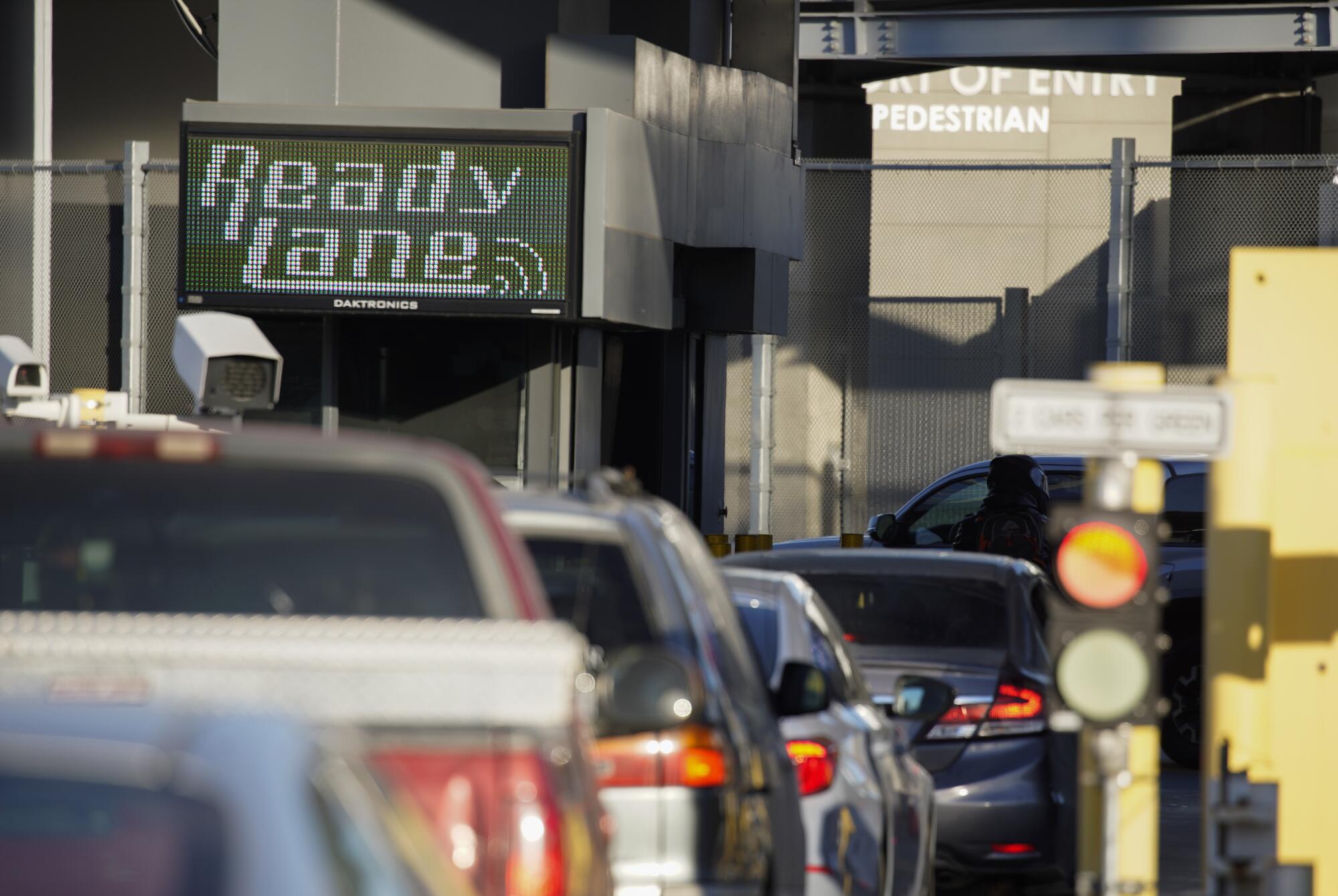
Guides on Russian-language YouTube
The San Diego Union-Tribune is aware of such crossings dating back to at least May 2021, when reporters covering another story in Tijuana were stuck in northbound border traffic early one morning after lanes were temporarily closed as officers responded to a carload of asylum seekers that had reached CBP’s inspection booths.
One advocate said she started hearing of the car crossings about a year ago. Another had heard of a similar strategy being used along the Arizona border in 2019.
The car lanes are particularly popular among Russian-speaking asylum seekers, who, according to some accounts, were the first to enter this way.
Russian-language YouTube videos offer guides for those wanting to try. Some suggest flying through Cancún to Tijuana. Asylum seekers flying into Mexico often stop in the city on the Caribbean coast to pretend to be tourists to get past Mexican immigration officials, who will stop travelers suspected of trying to reach the United States.
The vote is being hailed as a major triumph for workers in a country where union leaders and employers have long colluded to keep wages low.
In one video of a mother, father and their children, the couple rent a car and film themselves sitting in line at the border. Some of the videos show detailed plans of port of entry car lanes, including which ones are general lanes and which ones are SENTRI, or trusted traveler program, lanes.
In comments on another YouTube video of a man on a motorcycle riding up to the border, people ask questions about the yellow bumps on the ground. They know that those bumps are what they have to cross to reach safety.
The comments also indicate some of the political hostility that Russians might be fleeing. Some commenters call those who left for the United States traitors to their country.
The most recent U.S. State Department human rights report on Russia lists extrajudicial killings, forced disappearances, torture and arbitrary detention among the concerns there. The legal team with Jewish Family Service, a San Diego nonprofit that provides some asylum seekers with free attorneys, recently won two Russian cases.
Russians have long come to the San Diego-Tijuana border to request protection, including Tatars, an ethnic minority that faces discrimination and persecution back home. One Tatar man who spoke with the Union-Tribune in 2021 expressed frustration that he didn’t have enough money to find a place to stay or eat, while Russians of the majority ethnic background were able to get cars and enter the United States.
Economic status isn’t the only factor in determining who is able to use the car lanes to seek protection.
Once word began to spread in 2021 that some asylum seekers were making it into San Diego in cars, many others began attempting the method. But some were still not allowed in.
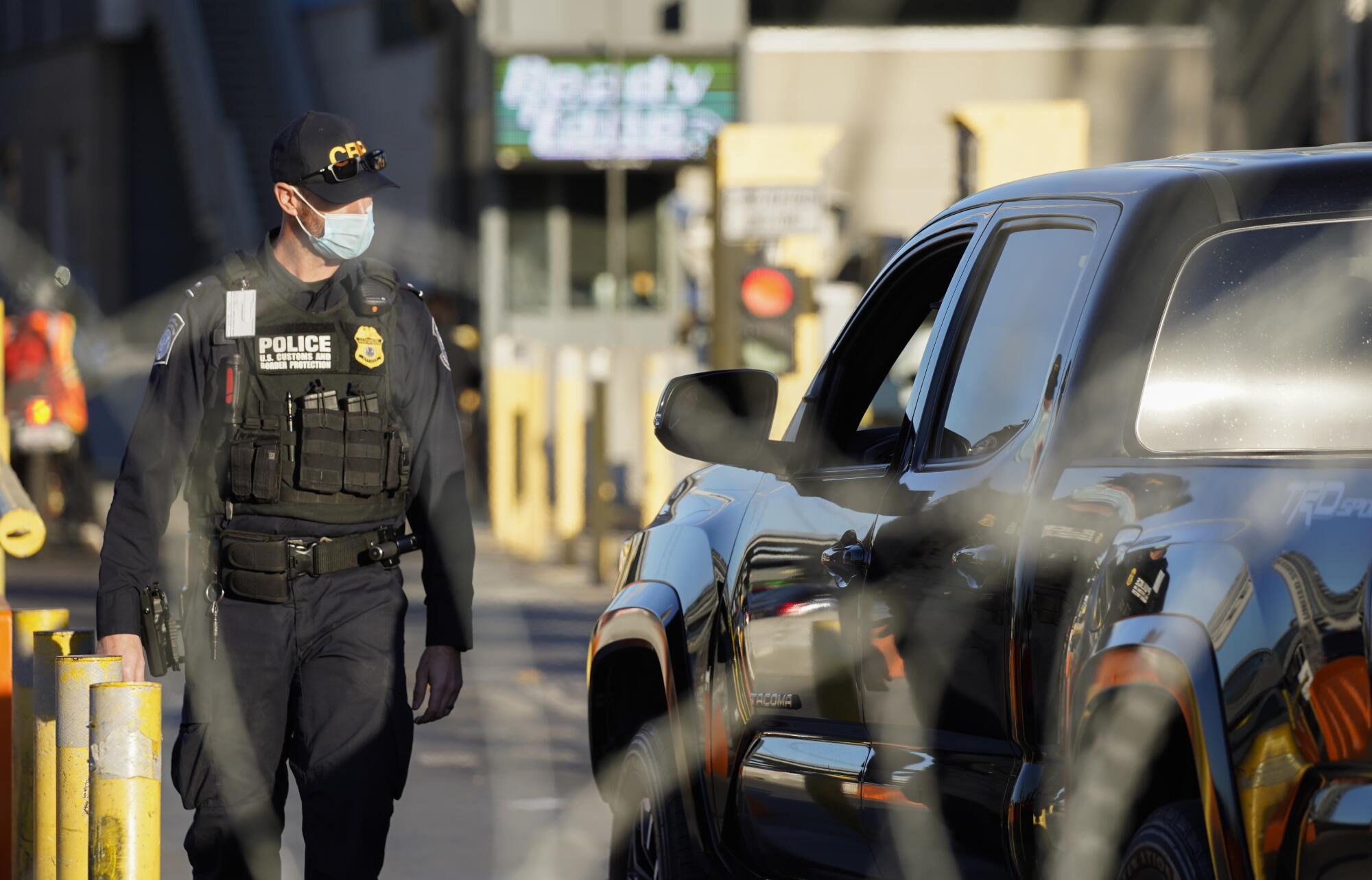
Pandemic policy restricts access to asylum
Two Mexican women from the state of Michoacán, where cartel violence and government corruption have forced many to flee, told the Union-Tribune in August 2021 that they had just tried crossing in a car with their children at the San Ysidro Port of Entry.
One woman had three children, and the other had two. The Union-Tribune isn’t identifying the women because of their vulnerable situation.
They were held in custody at the port until noon the next day, when U.S. officials sent them back to Tijuana, they said. They ended up at the Templo Embajadores de Jesús migrant shelter, confused and out of options.
“We asked for asylum,” one of the women said in Spanish. “They interviewed us and tossed us back here. They didn’t tell us anything.”
According to a document they received, they were expelled under the U.S. policy known as Title 42, which, under a pandemic order from the Centers for Disease Control and Prevention, tells border officials that they can send migrants back to Mexico or their home countries without giving them access to the asylum screening system. This policy was developed by the Trump administration, and President Biden’s team has defended it vigorously, including in federal court.
Four have been killed in the first month of this year alone. The government is fueling this wave of executions.
The interview that the woman referred to, the document said, was a special screening that migrants are supposed to be given if they proactively tell officials that they are afraid of being tortured in Mexico. The screening is difficult to pass.
Whom Title 42 applies to has evolved over the course of the pandemic and depends on which nationalities Mexico is willing to receive back and which countries have agreed to accept expulsion flights. For example, the United States recently began expelling some Venezuelan migrants on flights to Colombia, and U.S. officials have sent thousands of Haitians back to Haiti under the policy.
It does not appear that Title 42 has ever affected Russian border crossers in large numbers. Since it took effect in March 2020, only 100 Russians have been expelled, according to CBP data. That’s 0.3% of Russians taken into custody at the border during that time.
As a result, Russians are among the few nationalities fleeing their country to the United States in significant numbers who have been able to enter.
In June 2021, Russians moved into the top three nationalities hosted by the San Diego Rapid Response Network migrant shelter, according to weekly data posted on the shelter’s website. In September, Russia became the leading country of origin for asylum seekers hosted at the shelter. It remained in that position until the end of January this year, when it fell back to third.
In the months leading up to the pandemic, 300 to 400 Russians were taken into CBP custody each month at the border, almost all at ports of entry, according to data published by the agency going back to October 2019. While most nationalities’ monthly counts in border custody went down early in the pandemic because of lockdowns, the number of Russians increased to more than 800 per month that summer.
Their crossings continued to fluctuate until April, and they have increased steadily since, growing to more than 3,000 in December. CBP was unable to provide the Union-Tribune with historical data of Russian border crossings in order to determine whether this is a true increase from pre-pandemic patterns.
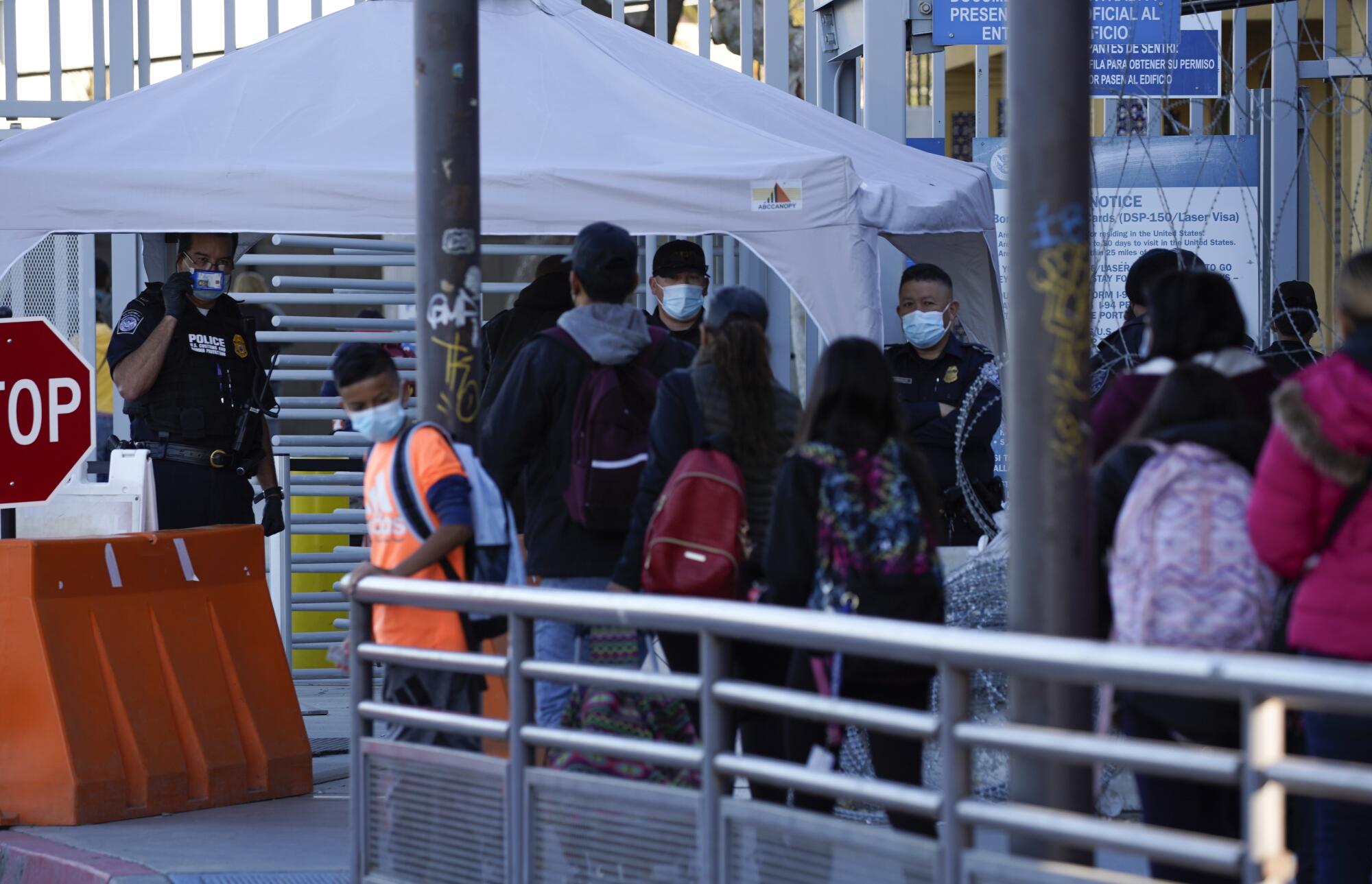
Illegal turnbacks
Advocates first noticed CBP officials turning back asylum seekers in pedestrian lines at the San Diego border in 2016, during the Obama administration. Officers standing at the limit line would tell asylum seekers that the port was at capacity or simply that they weren’t processing people for asylum.
Under former President Trump, that CBP tactic was formalized into a policy called “metering,” which limited the number of asylum seekers taken in by ports of entry each day. Backlogs of thousands of migrants formed in Mexico’s northern border cities, and asylum seekers from around the world ended up on waitlists often run by Mexican immigration officials.
U.S. officers would notify the managers of those lists how many people to send each day for processing.
U.S. officials argued that the policy was necessary to prevent holding cells at the ports of entry from being over capacity and to free up CBP resources to process documented travelers and to search for drug smuggling.
Meanwhile, advocates including Al Otro Lado filed a class-action lawsuit, arguing that turning back asylum seekers who were in the process of reaching U.S. soil to request protection was illegal. During the case, a CBP whistleblower came forward saying that the agency was lying about its capacity, and court documents filed by the plaintiffs note that government files obtained through discovery indicated that ports were operating below capacity when officials made claims that they couldn’t fit anyone else.
In September 2021, Judge Cynthia Bashant sided with the asylum seekers, ruling that it was illegal to turn them around when they were in the process of crossing to the United States for protection.
“Turnbacks are unlawful regardless of their purported justification,” Bashant wrote in her order.
She has not yet ruled on the remedy.
In the meantime, the United States government has continued to station officers at the limit line and send away asylum seekers. If they are able to stop a car from crossing onto U.S. soil, they call Mexican officials to help navigate the car back south, out of the way of border traffic.
“Legally an asylum seeker should just be able to drive into the United States and seek asylum. There’s nothing wrong with that. It’s a perfectly legal way to do it,” said Pinheiro of Al Otro Lado. “I would argue that posting officers at the limit line is illegal, and the court agreed with us, but they haven’t shown any signs of stopping.”
At a news conference last year, Thomas Reott, the U.S. Consul General in Tijuana, floated the idea of positioning officials farther south to check documents. He said the idea came from a brainstorming meeting with Mexican officials. If put into practice, that would mean Mexican officials would make sure northbound travelers have documents allowing them to enter the U.S. well before they reach the limit line.
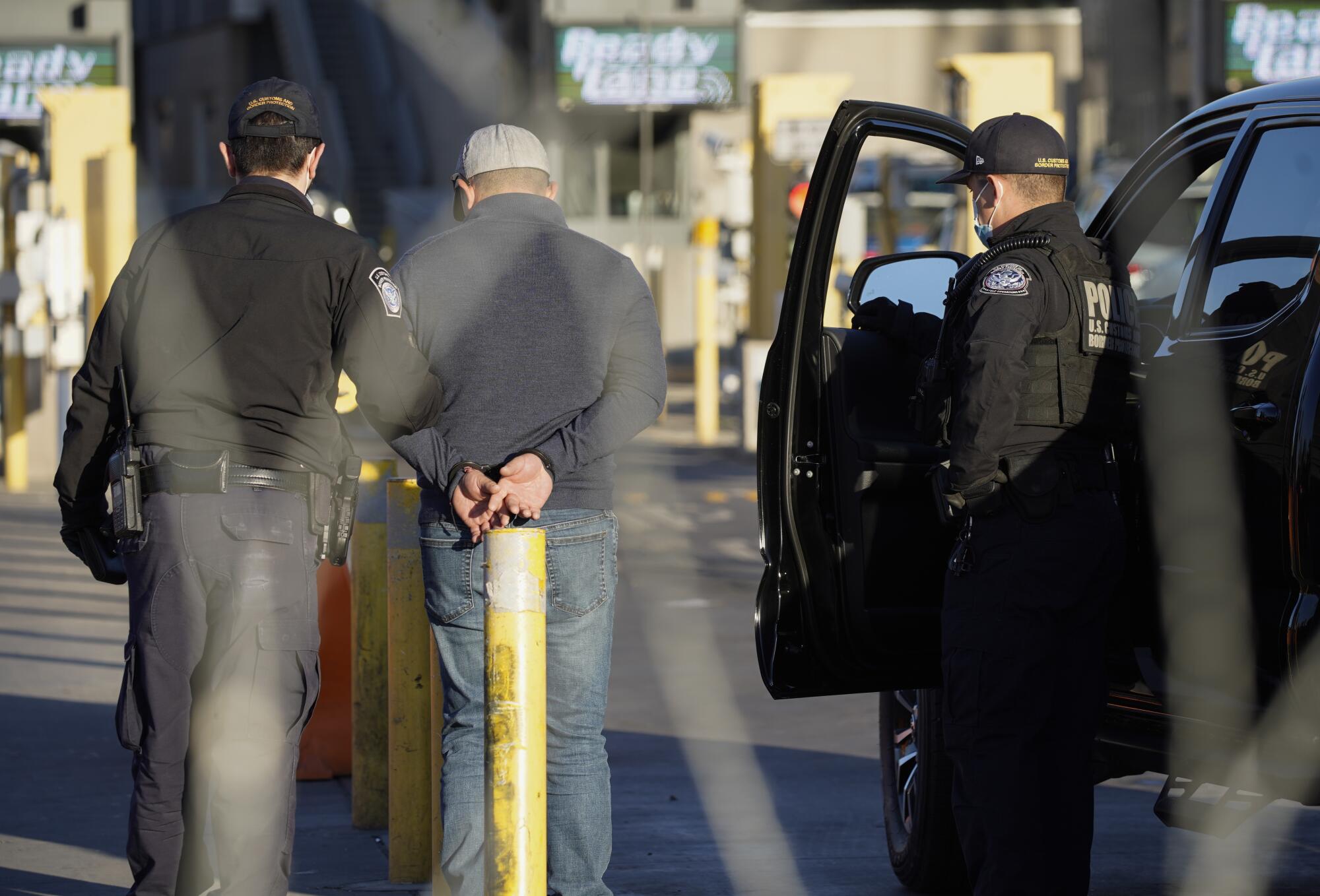
Prosecuted for car-lane crossings
Some asylum seekers have faced federal criminal prosecution after crossing onto U.S. soil in the car lanes, which could affect their ability to receive asylum in the future.
In December, as two cars filled with Russians were crossing onto U.S. soil, a CBP officer shot one of the cars, according to a statement from the agency. The first car stopped, and the second car, which was shot, ran into it. There were 12 people in the first car, including five children ages 5 and under. The second car had six people, including two children ages 10 and 14.
The CBP Use of Force Policy Handbook says that guns should not be used to stop moving cars. The Union-Tribune asked San Diego police for an update on the investigation into the incident but did not receive a response in time for publication.
Both drivers, who are themselves asylum seekers, have been charged in federal court with smuggling the passengers into the United States. The Union-Tribune conducted an extensive review of court records from 2021 and did not find any other case in which asylum seeker drivers were charged with smuggling passengers.
The U.S. attorney’s office in San Diego declined to be interviewed for this article.
Jorge Jaramillo, a criminal defense attorney representing one of the drivers, said his client was shaken by what happened. In representing the young man, who was a student back in Russia, Jaramillo will have to try to keep the case from affecting his ability to win protection. A smuggling conviction would be an automatic bar to asylum, according to immigration attorney Ginger Jacobs.
Asylum is discretionary, meaning that even if migrants can demonstrate they fled conditions that merit the protection, judges are supposed to determine whether candidates have “good moral character” before granting it. That means immigration judges will weigh the seriousness of convictions that do not automatically block someone from asylum.
The Union-Tribune also reviewed cases from 2021 involving charges of assaulting a federal officer, and found six, the oldest in August, in which the description in the complaint matches the profile of a migrant trying to reach U.S. soil. The drivers were charged because, in the process of crossing, their cars made contact with officers standing at the limit line.
In some cases, the description of the incident indicated that the car struck an officer’s hip or torso. In others, the car hit the officer’s hand.
Two of the six cases identified by the Union-Tribune specify that the people charged were intending to seek asylum. The Union-Tribune reached out to attorneys in the cases and though not all responded, those who did confirmed that their clients were asylum seekers as well.
In three of the cases, the drivers and passengers were Russian. In two of the cases, they were from Eastern Europe. In one case, the driver’s country of origin was not clear.
That driver, according to the complaint, told officials that he had learned of the technique for reaching U.S. soil to request protection from a family of Russians that he met in Mexico.
Alex Mensing of Innovation Law Lab, which supports asylum seekers in the region and has participated in several lawsuits over border policies meant to deter them, called charging asylum seekers in criminal court in connection to their entering through the car lanes ridiculous.
“That’s a really concerning sign of the criminalization of seeking asylum,” Mensing said.
He anticipated that the situation will only continue to worsen unless the United States begins processing asylum cases at ports of entry again.
More to Read
Sign up for Essential California
The most important California stories and recommendations in your inbox every morning.
You may occasionally receive promotional content from the Los Angeles Times.


